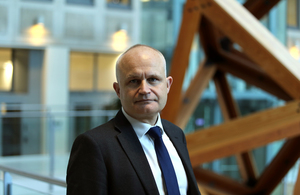Putting Child First into practice
By Professor Neal Hazel, YJB Board Member and Chair of Criminology and Criminal Justice at the University of Salford.

Professor Neal Hazel
The Youth Justice Board (YJB) has published revised case management guidance. I know that I, and many services, have been looking forward to this day and the much-needed clarification that the guidance provides.
The revised guidance accompanies the Lord Chancellor’s national standards for children in the youth justice system, which set out the minimum expectations for services. Crucially, it plugs a gap in our advice for how services should implement the standards in accordance with their guiding principle for youth justice – Child First. This will ensure that practice reflects contemporary understanding of what enables positive child outcomes, creating safer communities with fewer victims.
Each section of the guidance was reviewed, re-written and tested. In doing so, we gained valuable insights from across the sector into local practice on the ground. We incorporated changes in legislation, current research evidence, as well as the suitability of the language used.
We also listened to your requests to improve its usability and so rebuilt the guidance as a searchable manual.
We have published the revised guidance as soon as possible so you can take advantage of the revisions, but please note that updates to the out-of-court disposals and custody and resettlement sections will not be incorporated until the end of this year or early next year.
Updating the case management guidance was no easy feat because practice, evidence and understanding are ever evolving. It required a major collaborative effort, spanning three years of partnership working that involved the YJB team, professionals from across the youth justice system, government officials, children and young adults, academic researchers, and wider stakeholders. Much of their input came in particularly difficult circumstances, including during the pandemic. I can’t thank them enough for their resilience and commitment.
Please ensure that you spread the word about this revised guidance and encourage your colleagues to use it.
Involving professionals, third sector experts and academics
We needed to reflect experience and insights from the full spectrum of frontline professionals in local youth justice delivery. To do this we convened a user group of 28 members from across England and Wales, including frontline youth justice service (YJS) practitioners, health, court and police representatives, and colleagues from the secure estate. The user group’s expertise was invaluable.
To gain a broader perspective, we similarly benefitted hugely from the insights of our Quality of Advocacy Working Group, Voluntary and Community Sector Liaison Group and our Academic Liaison Network.
Involving children and young adults
Our Youth Advisory Network is a group of children and young adults with direct experience of the justice system. We developed specific sections of our guidance in collaboration with them and ensured that their voices helped to shape it.
We asked them for their views about how their practitioner can work with them better.
Children’s insights from lived experience proved vital. For instance, they made the powerful point that if they are ten minutes late for an appointment, they can be penalised, but it was not unusual to have to wait much longer for their worker if running late from other appointments or urgent business. They reflected that respect should go both ways – and we know from research that children mirror how they are treated by professionals. This is reflected in the guidance.
We also learnt that the assessment process is unlikely to be a neutral event for a child. This is particularly true for those who have experienced trauma. The telling (and re-telling) of their stories to individuals they do not know may be difficult and painful. This is because their YJS is often just one of many agencies which is assessing their needs.
These insights are reflected in new practical advice on how to involve children in their assessment as well as how best to interview them for reports. We adapted the guidance to encourage children to participate and tell their stories in their own way. We also guided practitioners to ask the child what interventions would assist and be meaningful to them.
Child First guidance
One of my roles was to chair a sub-committee of leading academics and stakeholders reviewing the evidence around some of the more challenging issues, such as remanding, intensive supervision, and breaching. At its heart, our advice tried to ensure that the guidance was in line with Child First.
Child First isn’t a phrase, mantra, or philosophy; it’s the published guiding principle for the youth justice sector. Essentially, it summarises our contemporary evidence-based understanding in youth justice.
And this understanding has progressed substantially in recent years, helping us to move beyond a deficit-focus on managing ‘risk of offending’, towards a more constructive focus helping children to make positive contributions to society. This has been reflected throughout the updated guidance.
The Child First principle has four tenets that summarise what is important in youth justice. It’s laid out in full in this document, but can be summed up in this simple ABCD:
As children
Recognise how children are developmentally different from adults and require different support.
Building pro-social identity
Promote children’s individual strengths and capacities to develop a pro-social identity, focusing on positive child outcomes rather than just trying to manage offending.
Collaborating with children
Involve children meaningfully to encourage their investment, engagement, and social inclusion.
Diverting from stigma
Promote supportive diversion from the criminal justice system where possible, or minimising stigma within it, as we know that stigma causes further offending.
Reflecting current evidence in our revised case management guidance is an important step towards to achieving a Child First youth justice system that enables children to make a constructive contribution to society. This will prevent offending and create safer communities with fewer victims.